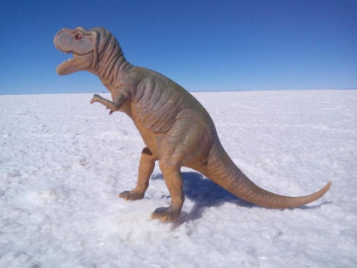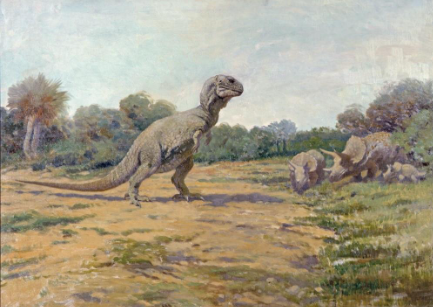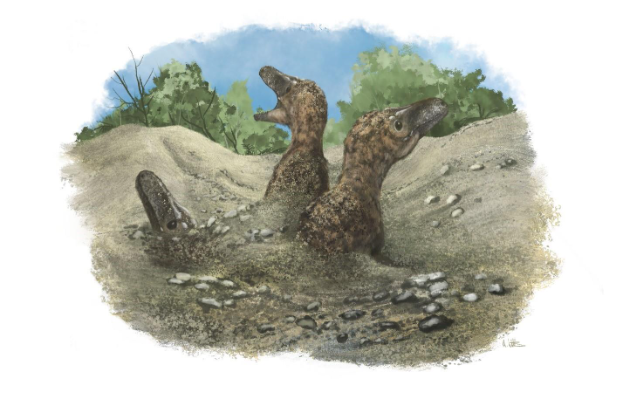What Did the King of the Dinosaurs Really Look Like? Part I
Remember that classic image of a Tyrannosaurus rex standing upright like a giant kangaroo, with its tail dragging behind, and roaring with its massive teeth exposed? Well, science has given our favourite dinosaur king a bit of a makeover! The T. rex, as we imagine it today, looks quite different from what scientists imagined over a century ago. Thanks to new paleontological discoveries and the clever work of researchers—and despite what Hollywood shows us—we now have a much better idea of what T. rex might have looked like.

To get a clearer picture, we spoke with Canadian paleontologist Thomas Cullen. He holds a PhD in Ecology and Evolution and is an assistant professor and curator at Auburn University in Alabama. He explains that our knowledge of T. rex is constantly evolving. Let’s take a look at some of the biggest changes science has revealed to us about this tyrant king!
Striking a Pose
One of the most striking changes has to do with T. rex’s posture. Early on, under the influence of fossil mounts and artists like Charles Knight, the king of dinosaurs was usually shown standing almost upright, using its tail for support. As Dr. Cullen explains: “They used to put them standing up like kangaroos, and now, of course, they stand more with the centre of mass around their hips and their tail acting as a counterweight to their front.”

By studying its bones more closely, scientists understood that its posture was actually much more horizontal. Its massive tail acted as a balance to counteract the weight of its enormous head. This position makes much more sense for a hunter as active and fast as this one. We used to see dinosaurs as immense, slow-moving beasts. We now think they were probably much more agile.
Feathers or Scales?
Here’s what’s really puzzling scientists: Did the tyrant lizard king have feathers? For large tyrannosaurids like T. rex, Gorgosaurus and Albertosaurus, Thomas Cullen is clear that there is no direct proof: “We only have skin impressions of them, with a bumpy sort of scaly texture, and we don’t have any actual feathers preserved on them.”
Yet, the idea isn't far-fetched. We know that many dinosaurs had feathers, especially the ancestors of birds (like tyrannosaurs!). Fossils have even been found of its smaller cousins covered in spectacular feathers. So why not T. rex? Unfortunately, “There’s evidence in either direction,” explains Dr. Cullen.
So, how do we solve this puzzle when it comes to the T. rex? Scientists aren’t sure. Some, like paleontologist and paleoartist Dr. Mark P. Witton, suggest that they might have had very sparse plumage, a bit like the hair on an elephant. Or that it lost its feathers as it became an adult, or perhaps, it had none at all. Dr. Witton explains: “Feathers, if present, were not distributed across the entire body. But given the size of T. rex and its existence in warm climates, I doubt it had many feathers at all. Feathers are fantastic insulators, […] so I expect T. rex would have benefited from minimized feathering.”
From Fluffy Hatchling to Scaly Adult
One of the most popular theories is that baby T. rex were born with downy feathers, like chicks, which they lost as they grew up to make way for scaly skin. Biologically, this is possible, since feathers are actually modified scales. But this transition from feathers to scales remains a mystery.

Dr. Alexandre Demers-Potvin, postdoctoral researcher at McGill University, explains: “It’s possible that certain [biological] signals led to feather growth in T. rex at a very young age, and then these signals changed as it grew, causing the feathers to fall out and be replaced by scales. These signals can vary across the body, which explains why birds have feathers on their arms or bellies, but scales on their feet.” The only problem is that no living animal today goes from feathers to scales in this way.
T. rex: A Work in Progress
With all these unanswered questions, it’s easier to understand why T. rex in museums and drawings are sometimes so different from one another.
The “Sue” dinosaur at the Field Museum in Chicago is presented without feathers, but the museum agrees they could have had them. The adult model from the American Museum of Natural History, currently at the Montréal Science Centre, is presented with a few hair-like proto-feathers, mainly on the top of its head and back, while their young T. rex is completely covered in feathers.
It’s proof that science never stops, and that our vision of dinosaurs continues to evolve with each new discovery!

We’ve uncovered some big changes in the T. rex’s stance and learned more about the deep question surrounding feathers, but there are still more secrets hiding about its true appearance! Get ready to explore more fascinating details about the tyrant lizard king. Stay tuned for Part II of “What did the King of the Dinosaurs really look like?”!
To learn more about T. rex and see the “hairy” T. rex, one of the most scientifically accurate reconstructions of this tyrant lizard, come visit our feature exhibition, T. rex: The Ultimate Predator! Take an even bigger bite of the T. rex experience and grab a combo ticket to see the IMAX® film T.REX 3D too!
Keep exploring:
https://www.cell.com/current-biology/fulltext/S0960-9822 (20) 31511-6?_returnURL=https%3A%2F%2Flinkinghub.elsevier.com%2Fretrieve%2Fpii%2FS0960982220315116%3Fshowall%3Dtrue
https://www.dailymotion.com/video/x8mmddi
